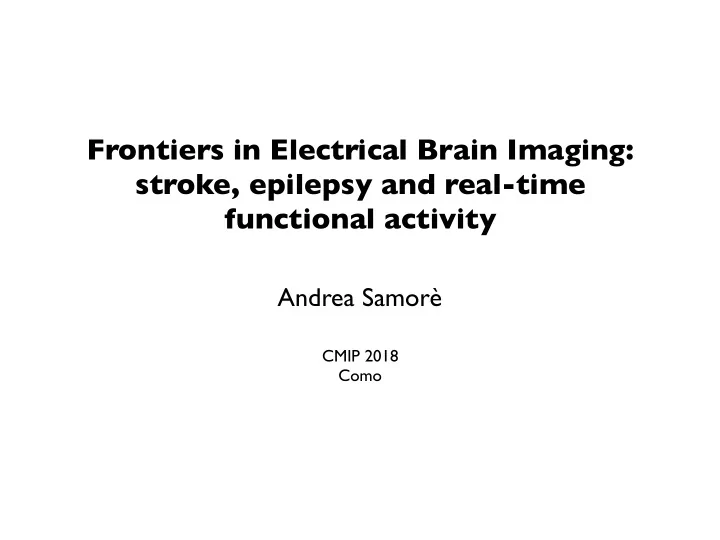

Frontiers in Electrical Brain Imaging: stroke, epilepsy and real-time functional activity Andrea Samorè CMIP 2018 Como
Electrical Brain Imaging Electrical brain imaging refers to the set of techniques that exploit electrical signals to generate an image of the structure or functional activity of the brain. • Quick setup • High computational requirements • Portability • Low spatial resolution [cm] • Low cost • High temporal resolution [ms] Electrical Impedance Tomography ( EIT ) ElectroEncephaloGraphy ( EEG ) An impedance map of the region of Electric potentials generated by interest is reconstructed from neurons are recorded. Waveforms at measured electric potentials different frequencies are associated generated by current injections to different mental states
Electrical Impedance Tomography The reconstruction is an underdetermined and ill-posed inverse problem. Three main components are generally required: • Electrical Model : describes the domain • Forward Problem Solver : computes the voltage distribution in the domain given the applied current injections and the electrical model • Inverse Problem Solver : Makes use of the forward problem solver to provide an estimate of the physical properties of the volume, given the stimulation pattern and the set of measurements.
Stroke Overview Life-threatening medical condition characterized by loss of brain function due to disruption of blood perfusion . • Ischemic : the blood supply to a brain region is reduced or completely cut off • Hemorrhagic : blood floods the region adjacent to the leakage of a vessel Early recognition and correct discrimination are crucial for effective therapy (4.5 h tPA limit).
EIT of Strokes Well defined electrical properties: • Ischemic strokes increase the impedance of the affected region • Hemorrhagic strokes decrease the impedance of the affected region Potential EIT use case: • Data acquisition with a portable EIT system is performed on site by a trained operator • Measured data (few KB) is sent offsite for image reconstruction and stroke detection and classification • The correct therapy is initiated as soon as possible
“State of the art” in applications Tikhonov regularized reconstruction Starting from an initial guess conductivity distribution, the conductivity of each voxel of the discretized domain is updated and a conductivity map of the region of interest is generated. General purpose algorithm Computationally expensive Provides shape approximation Regularization parameter optimization is critical
Alternative Approach parametric reconstruction • Each segmented head tissue is assigned a value according to literature data. • Compact conductivity anomaly is placed at an initial guess position. • Position and size of the anomaly and conductivity of the tissues are iteratively updated till convergence or disappearance of the moving anomaly. Faster and more accurate Special purpose algorithm than Tikhonov
Phantom Example
Focal Epilepsy Overview A limited part of the brain, the epileptogenic focus, initiates an abnormal activity which can spread to other brain regions. If pharmacoresistant, then treatment consists in surgical resection of the epileptogenic focus. • Various noninvasive imaging techniques can be used for localization both from a structural (MRI) and a functional (PET, SPECT, (video)EEG,..) perspective • If no definitive conclusion, invasive EEG measurements can be performed (SEEG) Standard analysis consists in looking at raw data to locate the initiating focus.
Surgical Resection After localization, first surgery alleviates or remove symptoms only in about 60% of the cases. Patient may have to return for second surgery. • Multiple foci • Insufficient resection There is room for improvement! • SEEG electrodes can be used to both measure potentials (EEG) or inject currents (cortical mapping) • Recent research highlights a 10% difference in conductivity between epileptic and non-epileptic cortex • Possible to attempt time difference EIT imaging • EIT may provide a direct, independent measurement of epileptic activity
Epilepsy Imaging Workflow Tikhonov algorithm preferred to parametric approach due to the highly inhomogeneous background (SEEG electrodes).
Simulation Experiments • Average resection volume: 30cm^3 → sphere with 4 cm diameter • EIT resolution: ≈ cm • Completely new source of information with clinical significance • Only slight modification of the clinically used SEEG protocol is required
EEG Introduction • Recording of electric potentials generated by the activity of neurons. • Generally measured on the scalp. • Commonly used to diagnose brain disorders associated to its electrical activity (epilepsy, brain tumors, sleep disorders).
Brain Imaging through EEG • Identify which region of the brain produced the electrical signal recorded on the scalp and produce a functional map of brain activity. • Inverse problem (underdetermined and ill posed). To attack the problem, an electrical model of the brain is needed. The electrical model can be fine-tuned to the specific subject using EIT measurements.
Inverse Problem Identify the current density J in each voxel of the domain that corresponds to the electric potentials measured on the scalp Φ Electric Potentials (known) Current Density Lead Field (unknown) Matrix (built with EM) sLORETA s tandardized LO w R esolution brain E lectromagnetic T omogr A phy can localize test point sources with zero localization error in the absence of noise N v N v
CREAM : CR eativity E nhancement through A dvanced brain M apping and stimulation http://www.ict-cream.eu/project_sticky/ • Goal: measure functional activity of the brain and compute real-time stimuli to modulate a high-level behaviour such as creativity • Previous studies have shown that electrical stimulation can modulate verbal associative thoughts, problem solving, insight.... • Cognitive psychology • Current stimuli (tDCS, tACS,...) and visual and acustic • Neuroscience stimuli. • Engineering • Engineering & ICT: link measurement and electrical stimulation • ICT • Need quick reconstructions to inform stimulation in real time
Parallel Implementation 128 Electrodes 90K Voxels The openMP + CUDA Solving time [s] implementation of sLoreta solves the inverse problem in less than a second (sampling rate 128). • Real Time Reconstruction. • Integration between measurement and stimulation. Sampling Rate [samples/s]
Questions?
Recommend
More recommend